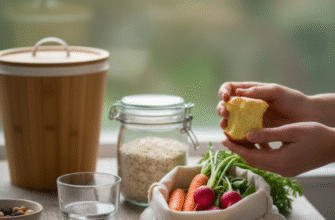Stuck indoors? Whether it’s pouring rain, too hot to handle outside, or you’re just looking for a new way to banish boredom, creating your own fun is often the best solution. Forget complicated board games or expensive kits. You likely have everything you need right now for a classic game with a homemade twist: indoor bowling! Using just some empty bottles and a soft ball, you can set up a bowling alley in your hallway or living room in minutes. It’s surprisingly engaging, adaptable for different ages and skill levels, and best of all, practically free.
This isn’t about replicating the polished lanes and heavy balls of a commercial bowling alley. It’s about embracing the DIY spirit, getting a little creative, and enjoying some simple, active fun without leaving the house. It’s perfect for families with kids, roommates looking for a silly challenge, or even just a solo activity to break up the monotony of the day. The slight wobble of the plastic bottles, the gentle thud of the soft ball – it all adds to the unique charm of this homemade game.
Gathering Your Bowling Essentials
The beauty of indoor bottle bowling lies in its simplicity. You don’t need specialized equipment. Take a quick look around your home, especially the recycling bin, and you’ll likely find your core components.
The Pins: Your Trusty Bottles
Empty plastic bottles are the stars of the show. Here’s what to consider:
- Type: Standard 16-20 oz plastic water or soda bottles work perfectly. Ensure they are empty, rinsed, and dry. Uniformity helps, so try to gather bottles of the same size and shape if possible, though a mixed set can add an unpredictable challenge!
- Quantity: Traditional bowling uses ten pins. However, you can easily adapt. Six pins arranged in a smaller triangle is often easier to manage in tighter indoor spaces and quicker to set up. Feel free to experiment – maybe try just three for toddlers or go for the full ten for a more authentic feel.
- Stability (Optional): Lightweight plastic bottles can be knocked over very easily, sometimes even by a near miss or a slight breeze. If you find them too unstable, you can add a small amount of weight. Try adding an inch or two of water, sand, rice, or dried beans to the bottom of each bottle. Remember to put the caps back on tightly! This adds just enough heft to make them stand up reliably but still easy enough to topple with a soft ball.
- Decoration (Optional Fun): Get creative! Let kids (or adults!) decorate the bottles. Use markers, paint pens (acrylic works best on plastic), stickers, or wrap them in coloured paper. You could number them, draw funny faces, or create team colours. This personalization step adds to the fun and ownership of the game.
The Bowling Ball: Soft and Safe
Leave the heavy resin balls at the alley. For indoor play, safety and preventing damage are key. You need something soft.
- Ideal Choices: A foam ball, a soft sponge ball (like a Nerf ball), or even a small, soft playground ball are excellent options. These are lightweight, won’t damage walls or furniture easily, and are safe for all ages.
- DIY Alternatives: No suitable ball? No problem! Tightly roll up a few pairs of thick socks into a ball shape. Secure it with a rubber band or another sock pulled over the top if needed. You could also use a small, soft stuffed animal (one that’s somewhat spherical) or even crumpled paper tightly bound with tape.
- Size Matters: Choose a ball that’s comfortable to hold and roll for the players. It should be large enough to reliably knock over the lightweight bottles but not so large that it’s unwieldy or knocks them all down too easily every time.
The Bowling Lane: Your Indoor Space
You don’t need polished wood, just a clear path.
- Location: Hallways are often the perfect natural bowling lane due to their length and defined sides. A clear stretch of floor in a living room, playroom, or even a large kitchen can also work well. Ensure the surface is relatively smooth – carpet, tile, wood, or vinyl flooring are all suitable.
- Clearing the Area: This is crucial for safety and uninterrupted play. Move furniture, toys, rugs (if they slip easily), and any breakable items well out of the way of the lane and the pin area. You need a clear path for rolling the ball and space around the pins for them to scatter without hitting anything valuable or fragile.
- Defining Boundaries (Optional): While a hallway provides natural boundaries, in an open room, you might want to define the lane. Use masking tape or painter’s tape (which usually removes easily without residue) to mark the sides of the lane and the throwing line (the foul line). This adds a touch of structure to the game.
Setting Up and Playing the Game
With your gear gathered, setting up takes just a couple of minutes.
Arranging the Pins
The classic setup is a triangular formation. For ten pins, arrange them in rows: one pin in the front, then two behind it, then three, then four. For six pins, use rows of one, then two, then three. Place the triangle at the far end of your designated lane. Ensure there’s a little space between the bottles so they don’t all fall down from just one hitting the front pin (unless that’s the kind of chaotic fun you’re after!). Adjust the spacing based on the ball size and desired difficulty.
Marking the Foul Line
Decide where players will stand or kneel to roll the ball. Mark this spot with tape, a cushion, or even just a designated floor tile or carpet pattern feature. This ensures everyone bowls from the same distance, keeping the game fair.
The Rules of Indoor Bowling
Keep it simple or get competitive – it’s up to you!
Basic Play:
- Players take turns rolling the ball down the lane towards the pins.
- Each player usually gets two rolls per turn (or “frame”) to knock down as many pins as possible, just like standard bowling.
- Count how many pins are knocked down after each turn. A pin only counts if it’s knocked over completely.
- Reset the pins for the next player.
- Decide on a number of turns (e.g., 5 or 10 frames per player) or play until someone reaches a target score. The player with the highest score at the end wins.
Simple Scoring: Just count the total number of pins knocked down by each player throughout the game.
Slightly More Advanced Scoring (Optional): If you want to mimic real bowling a bit more closely:
- Strike (X): Knocking down all pins on the first roll of a frame. Score 10 points plus a bonus of the pins knocked down on the next two rolls.
- Spare (/): Knocking down all remaining pins on the second roll of a frame. Score 10 points plus a bonus of the pins knocked down on the next one roll.
- Open Frame: Failing to knock down all pins after two rolls. Score only the number of pins knocked down in that frame.
Keeping track of strikes and spares can be a fun challenge for older kids and adults, but simply counting pins works great for everyone.
Spice It Up: Fun Variations
Once you’ve mastered the basics, try these fun twists:
- Obstacle Bowling: Place soft obstacles like cushions, stuffed animals, or cardboard boxes in the lane that players have to navigate around.
- Trick Shots: Challenge players to roll the ball between their legs, backwards, or with their non-dominant hand.
- Team Play: Divide into teams and alternate players or combine scores for a cooperative or competitive team challenge.
- Different Setups: Don’t stick to the triangle! Arrange pins in a straight line, a circle, or a random pattern.
- Multiple Balls: Give younger players two smaller, lighter balls to roll simultaneously or in quick succession.
- Timed Rounds: See how many pins a player or team can knock down in a set time limit (e.g., one minute), including resetting time.
Safety First! Always prioritize safety during indoor play. Ensure the chosen ball is genuinely soft to prevent injury or damage to walls, furniture, or decorations. Supervise young children during setup and play. Make absolutely certain the bowling lane and surrounding area are clear of any breakable items or tripping hazards before you begin. Clear communication about staying out of the “lane” while someone is bowling is also important.
Ready, Set, Roll!
Indoor bottle bowling is more than just a way to pass the time; it’s a fantastic opportunity for screen-free fun, creativity, and a little bit of physical activity. It encourages problem-solving (how to best knock down those pins?), coordination, and friendly competition. The setup is minimal, the cost is negligible, and the potential for laughter and enjoyment is huge.
So next time you’re searching for an easy and engaging indoor activity, look no further than your recycling bin and a soft ball. Gather your supplies, clear a space, set up your makeshift pins, and let the good times roll. You might be surprised at how much fun you can have with such simple materials. Happy bowling!








